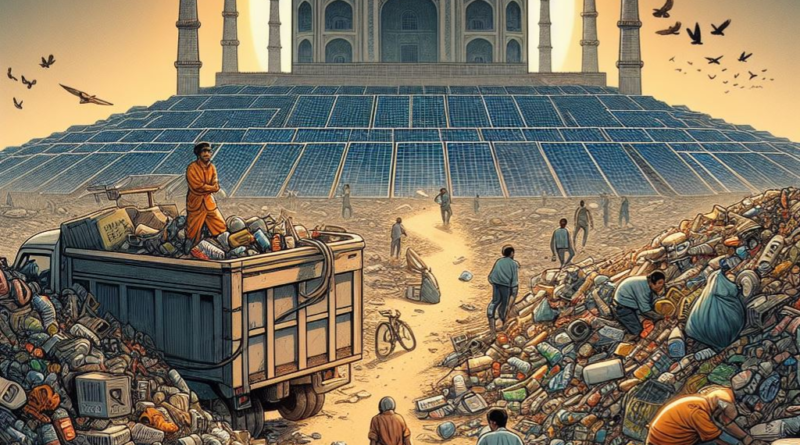India’s Growing Solar Waste Crisis Highlighted | Ias Banenge
Context:
A report titled ‘Enabling a Circular Economy in India’s Solar Industry – Assessing the Solar Waste Quantum’ has drawn attention to India’s increasing solar waste issue. The study was undertaken by the Ministry of New and Renewable Energy (MNRE) in partnership with experts from the Council on Energy, Environment and Water, a prominent not-for-profit policy research institution in Asia. This report underscores the need for sustainable solutions to manage and recycle solar waste in India’s burgeoning solar industry.
Relevance:
GS III: Indian Economy
READ MORE- Ukraine Reports Russian Use of Hypersonic Missiles in Kyiv Attacks
Dimensions of the Article:
- Key Highlights of the Report
- What is Solar Waste?
- Challenges of Solar Waste Recycling in India
Key Highlights of the Report
Solar Capacity and Waste Generation
- India’s solar capacity as of FY23 has produced approximately 100 kilotonnes (kt) of cumulative waste.
- By 2030, this waste is projected to rise to 340 kt.
- A 32-fold increase is expected by 2050, leading to around 19,000 kt of cumulative waste.
- 77% of the waste anticipated by 2050 will stem from new capacities.
State-wise Waste Production
- Five states, namely Rajasthan, Gujarat, Karnataka, Tamil Nadu, and Andhra Pradesh, are predicted to account for about 67% of the projected waste by 2030.
- Rajasthan is set to generate 24% of the waste by 2030, with Gujarat contributing 16%, and Karnataka 12%.
Minerals in Discarded Solar Modules
- Discarded solar modules contain crucial minerals vital for India’s economic growth and national security.
- These minerals include silicon, copper, tellurium, and cadmium.
- The estimated 340 kt of waste by 2030 is expected to include 10 kt of silicon, 12-18 tonnes of silver, and 16 tonnes of cadmium and tellurium.
Recommendations
MNRE Database Maintenance
- The Ministry of New and Renewable Energy (MNRE) should establish and routinely update a database detailing the installed solar capacity.
- This database should encompass information like module technology, manufacturer, commissioning date, etc., to accurately pinpoint potential waste generation hubs.
Guidelines for Solar Waste Management
- The Ministry of Environment, Forest and Climate Change should formulate and release guidelines for the collection and storage of solar waste.
- Additionally, efforts should be made to promote the safe and efficient processing of this stored waste.
Responsibility of Solar Producers
- Solar cell and module manufacturers should initiate the development of waste collection and storage centers.
- This action is necessary to comply with the obligations set forth in the Electronic Waste Management Rules 2022.
What is Solar Waste?
Definition and Origin
- Solar waste encompasses waste generated during the manufacturing of solar modules and includes discarded modules and scrap from the manufacturing process.
- Modules are typically discarded either at the end of their operational life or due to damages incurred during transportation, handling, or installation.
Importance of Proper Handling
- Improper handling and disposal methods for solar waste should be avoided.
- Proper treatment is crucial to recover valuable minerals and prevent the leaching of toxic substances like lead and cadmium.
Recyclability of Solar Waste
- According to the International Renewable Energy Agency (IRENA), approximately 80% of solar panel components, including materials like glass and metal frames, are recyclable.
- Solar waste can be recycled to reclaim materials such as glass, aluminium, copper, silicon, and silver.
- Recycling methods can be categorized into mechanical, thermal, and chemical processes, each aiding in the recovery of specific minerals with varying purity grades.
Challenges of Solar Waste Recycling in India
Lack of Comprehensive Laws
- The absence of specific and comprehensive laws addressing solar waste management in India impedes the establishment of standardized recycling practices.
- This may lead to inconsistent recycling efforts across the country.
Complex Composition of Solar Panels
- Solar panels comprise diverse materials, including silicon, glass, and aluminium, along with hazardous elements like lead and cadmium.
- Effective recycling requires the separation of these components, which demands specialized technology that is often costly and not readily available in India.
Informal Recycling Practices
- A significant portion of solar waste in India is handled by informal recyclers.
- These informal sectors often lack proper safety measures and may engage in environmentally detrimental practices.
Economic Feasibility Concerns
- The insufficient demand for recycled materials, such as silicon wafers or glass cullet from solar panels, undermines the economic viability of recycling initiatives in India.
-Source: Indian Express





Pingback: Paira Cropping System | Ias Banenge - Ias Banenge